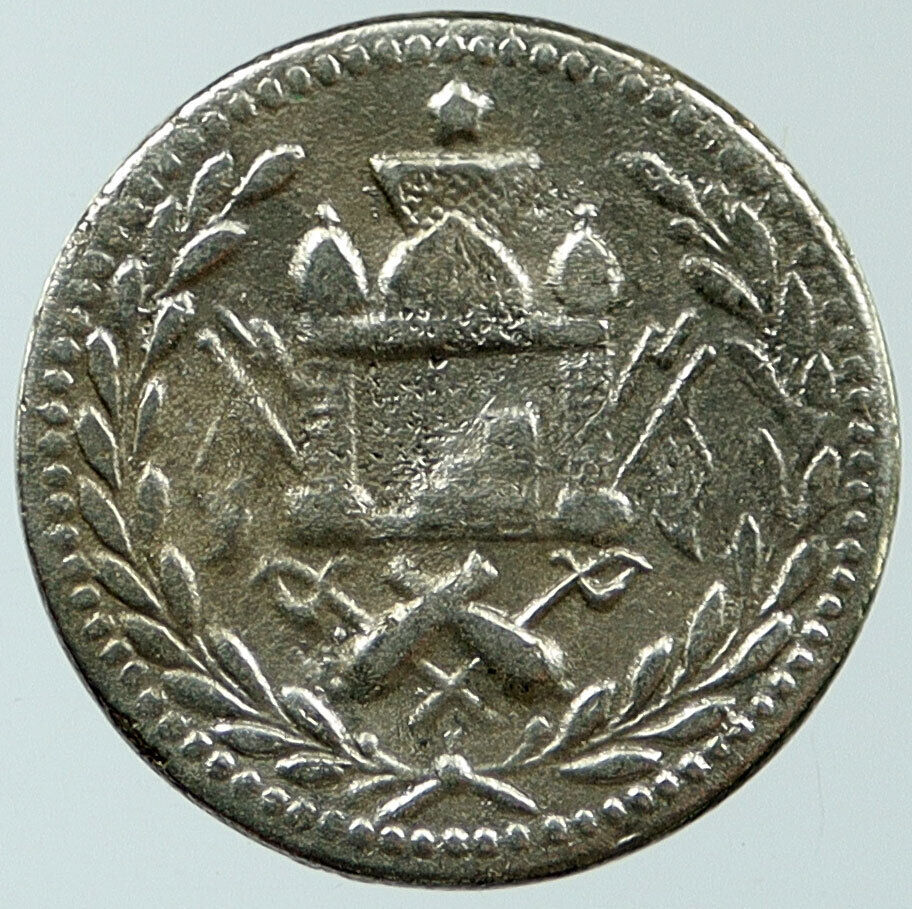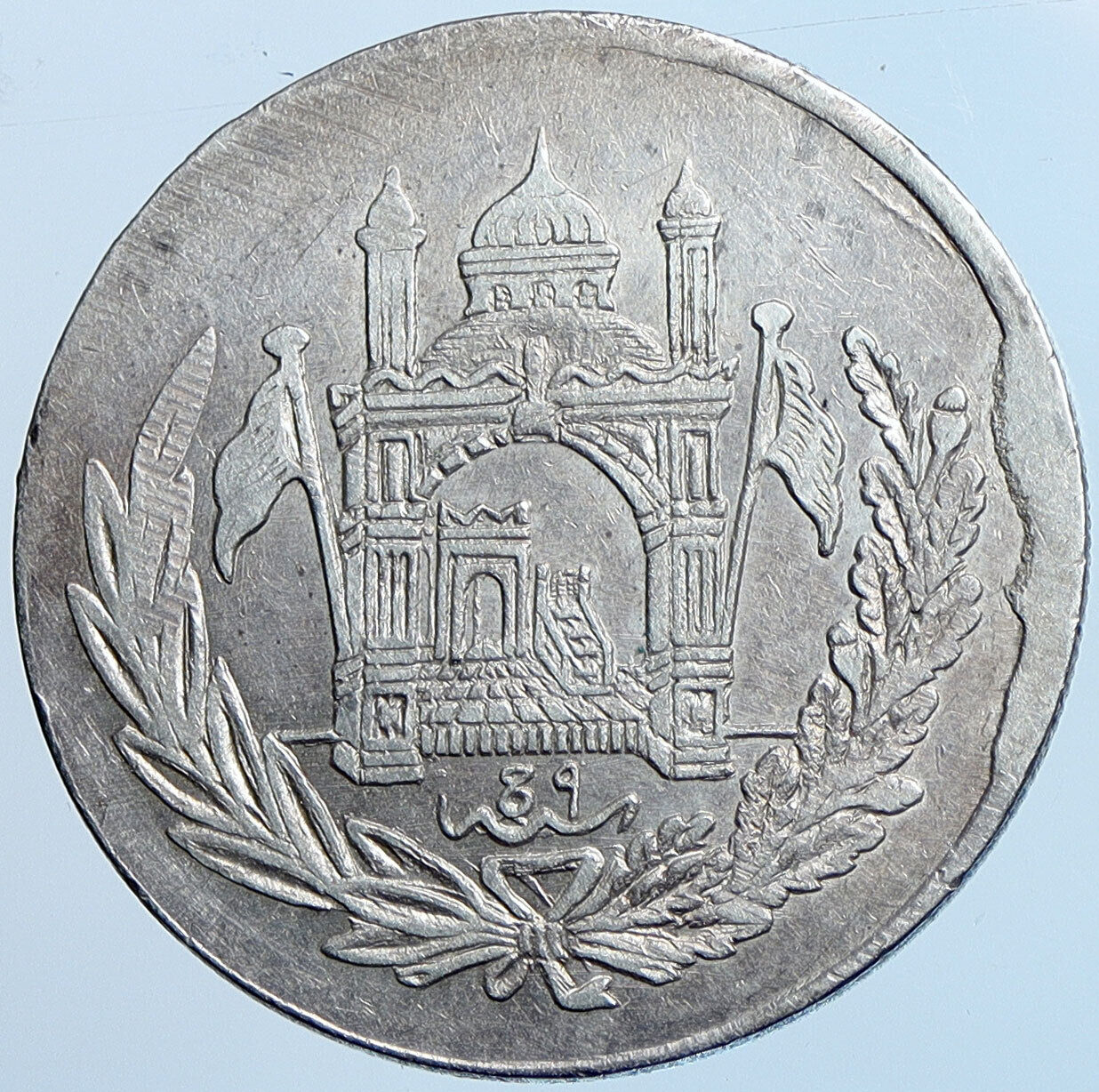|
Afghanistan – 1990 FIFA World Soccer Championship in Italy
1990 Proof Silver 500 Afghanis 38mm (15.93 grams) 0.999 Silver (0.5139 oz. ASW)
Reference: KM# 1011
DEMOCRATIC REPUBLIC OF AFGHANISTAN 500 AFGHANIS, State emblem.
WORLD FOOTBALL CHAMPIONSHIP ITALY 1990 1989, Two footballers, one with ball with crown in background.
You are bidding on the exact item pictured, provided with a Certificate of Authenticity and Lifetime Guarantee of Authenticity.
 The 1990 FIFA World Cup was the 14th FIFA World Cup, the quadrennial international football tournament. It was held from 8 June to 8 July 1990 in Italy, the second country to host the event twice (the first being Mexico in 1986). Teams representing 116 national football associations entered and qualification began in April 1988. 22 teams qualified from this process, along with host nation Italy and defending champions Argentina. The 1990 FIFA World Cup was the 14th FIFA World Cup, the quadrennial international football tournament. It was held from 8 June to 8 July 1990 in Italy, the second country to host the event twice (the first being Mexico in 1986). Teams representing 116 national football associations entered and qualification began in April 1988. 22 teams qualified from this process, along with host nation Italy and defending champions Argentina.
The tournament was won by West Germany, their third World Cup title. They beat Argentina 1-0 at the Stadio Olimpico in Rome, a rematch of the previous final four years earlier. Italy finished third and England fourth, after both lost their semi-finals in penalty shootouts. This was the last tournament to feature a team from West Germany, with the country being reunified with East Germany a few months later in October, as well as teams from the Eastern Bloc prior to the end of the Cold War in 1991, as the Soviet Union, Romania, Czechoslovakia and Yugoslavia teams made appearances. Costa Rica, Ireland and the UAE made their first appearances in the finals. As of 2018, this was the last time the UAE qualified for a FIFA World Cup finals. The official match ball was the Adidas Etrusco Unico.
The 1990 World Cup is widely regarded as one of the poorest World Cups in terms of the games. It generated an average 2.2 goals per game – a record low that still stands – and a then-record 16 red cards, including the first ever dismissal in a final. Regarded as being the World Cup that has had perhaps the most lasting influence on the game as a whole, it saw the introduction of the pre-match Fair Play Flag (then inscribed with “Fair Play Please”) to encourage fair play. Defensive tactics led to the introduction of the back-pass rule in 1992 and three points for a win instead of two at future World Cups. The tournament also produced some of the World Cup’s best remembered moments and stories, including the emergence of African nations, in addition to what has become the World Cup soundtrack: “Nessun dorma”.
The 1990 World Cup stands as one of the most watched events in television history, garnering an estimated 26.69 billion non-unique viewers over the course of the tournament. This was the first World Cup to be officially recorded and transmitted in HDTV by the Italian broadcaster RAI in association with Japan’s NHK. The huge success of the broadcasting model has also had a lasting impact on the sport. At the time it was the most watched World Cup in history in non-unique viewers, but was bettered by the 1994 and 2002 World Cups.
 The Islamic Republic of Afghanistan, is a landlocked country located within south-central Asia. Afghanistan is bordered by Pakistan in the south and east; Iran in the west; Turkmenistan, Uzbekistan, and Tajikistan in the north; and in the far northeast, China. Its territory covers 652,000 square kilometers (252,000 sq mi) and much of it is covered by the Hindu Kush mountain range, which experience very cold winters. The north consists of fertile plains, whilst the south-west consists of deserts where temperatures can get very hot in summers. Kabul serves as the capital and its largest city. The Islamic Republic of Afghanistan, is a landlocked country located within south-central Asia. Afghanistan is bordered by Pakistan in the south and east; Iran in the west; Turkmenistan, Uzbekistan, and Tajikistan in the north; and in the far northeast, China. Its territory covers 652,000 square kilometers (252,000 sq mi) and much of it is covered by the Hindu Kush mountain range, which experience very cold winters. The north consists of fertile plains, whilst the south-west consists of deserts where temperatures can get very hot in summers. Kabul serves as the capital and its largest city.
Human habitation in Afghanistan dates back to the Middle Paleolithic Era, and the country’s strategic location along the Silk Road connected it to the cultures of the Middle East and other parts of Asia. The land has historically been home to various peoples and has witnessed numerous military campaigns, including those by Alexander the Great, Mauryas, Muslim Arabs, Mongols, British, Soviet, and since 2001 by the United States with NATO-allied countries. It has been called “unconquerable” and nicknamed the “graveyard of empires”. The land also served as the source from which the Kushans, Hephthalites, Samanids, Saffarids, Ghaznavids, Ghorids, Khaljis, Mughals, Hotaks, Durranis, and others have risen to form major empires.
The political history of the modern state of Afghanistan began with the Hotak and Durrani dynasties in the 18th century. In the late 19th century, Afghanistan became a buffer state in the “Great Game” between British India and the Russian Empire. Its border with British India, the Durand Line, was formed in 1893 but it is not recognized by the Afghan government and it has led to strained relations with Pakistan since the latter’s independence in 1947. Following the Third Anglo-Afghan War in 1919 the country was free of foreign influence, eventually becoming a monarchy under King Amanullah, until almost 50 years later when Zahir Shah was overthrown and a republic was established. In 1978, after a second coup Afghanistan first became a socialist state and then a Soviet Union protectorate. This evoked the Soviet-Afghan War in the 1980s against mujahideen rebels. By 1996 most of Afghanistan was captured by the Islamic fundamentalist group the Taliban, who ruled most of the country as a totalitarian regime for over five years. The Taliban were forcibly removed by the NATO-led coalition, and a new democratically-elected government political structure was formed.
Afghanistan is a unitary presidential Islamic republic with a population of 35 million, mostly composed of ethnic Pashtuns, Tajiks, Hazaras and Uzbeks. It is a member of the United Nations, the Organisation of Islamic Cooperation, the Group of 77, the Economic Cooperation Organization, and the Non-Aligned Movement. Afghanistan’s economy is the world’s 108th largest, with a GDP of $64.08 billion; the country fares much worse in terms of per-capita GDP (PPP), ranking 167th out of 186 countries in a 2016 report from the International Monetary Fund.
|





 The 1990 FIFA World Cup was the 14th FIFA World Cup, the quadrennial international football tournament. It was held from 8 June to 8 July 1990 in Italy, the second country to host the event twice (the first being Mexico in 1986). Teams representing 116 national football associations entered and qualification began in April 1988. 22 teams qualified from this process, along with host nation Italy and defending champions Argentina.
The 1990 FIFA World Cup was the 14th FIFA World Cup, the quadrennial international football tournament. It was held from 8 June to 8 July 1990 in Italy, the second country to host the event twice (the first being Mexico in 1986). Teams representing 116 national football associations entered and qualification began in April 1988. 22 teams qualified from this process, along with host nation Italy and defending champions Argentina.  The Islamic Republic of Afghanistan, is a landlocked country located within south-central Asia. Afghanistan is bordered by Pakistan in the south and east; Iran in the west; Turkmenistan, Uzbekistan, and Tajikistan in the north; and in the far northeast, China. Its territory covers 652,000 square kilometers (252,000 sq mi) and much of it is covered by the Hindu Kush mountain range, which experience very cold winters. The north consists of fertile plains, whilst the south-west consists of deserts where temperatures can get very hot in summers. Kabul serves as the capital and its largest city.
The Islamic Republic of Afghanistan, is a landlocked country located within south-central Asia. Afghanistan is bordered by Pakistan in the south and east; Iran in the west; Turkmenistan, Uzbekistan, and Tajikistan in the north; and in the far northeast, China. Its territory covers 652,000 square kilometers (252,000 sq mi) and much of it is covered by the Hindu Kush mountain range, which experience very cold winters. The north consists of fertile plains, whilst the south-west consists of deserts where temperatures can get very hot in summers. Kabul serves as the capital and its largest city. 




